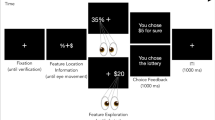Abstract
An “unprocessed risk” is a collection of simple lotteries with a reduction-rule that describes the actual-payoff to the decision-maker as a function of realized lottery outcomes. Experiments reveal that the willingness to pay for unprocessed risks is consistently biased toward the payoff-level in the unprocessed representation. The “anchoring-to-frame” bias in cases of positive framing is significantly weaker than in cases of negative framing suggesting that rational “negativity bias” may reflect in asymmetric violations of rationality.
Similar content being viewed by others
References
Bell D. (1982) Regret in decision-making under uncertainty. Operations Research 20: 961–981
Biernat M. (2005) Standards and expectancies: Contrast and assimilation in judgments of self and others. Psychological Press, New York
Birnbaum M. H. (2007) Tests of branch splitting and branch-splitting independence in Allais paradoxes with positive and mixed consequences. Organizational Behavior and Human Decision Processes 102(2): 154–173
Budescu D. V., Fischer I. (2001) The same but different: An empirical investigation of the reducibility principle. Journal of Behavioral Decision Making 14: 187–206
De Martino B., Kumaran D., Seymour B., Dolan R. J. (2006) Frames, biases and rational decision-making in the human brain. Science 313(5787): 684–687
Gigerenzer G., Selten R. (2001) Bounded rationality: The adaptive toolbox. MIT Press, Cambridge, MA
Gul F. (1991) A theory of disappointment aversion. Econometrica 59: 667–686
Higgins E. T., Lurie L. (1983) Context, categorization and recall: The change of standard effect. Cognitive Psychology 15(4): 525–547
Huck S., Weizsäcker G. (1999) Risk, complexity and deviations from expected utility maximization: Results of a lottery choice experiment. Journal of Economic Psychology 20(6): 699–715
Kahneman D. (1994) New challenges to the rationality assumption. Journal of Institutional and Theoretical Economics 150(1): 18–36
Kahneman D., Tversky A. (1979) Prospect theory: An analysis of decision under risk. Econometrica 47: 363–391
Kanouse D. E., Hanson L. R. (1972) Negativity in evaluations. In: Jones E. E.et al. (eds) Attribution: Perceiving the causes of behavior. General Learning Press, Morristown, NJ
Levine I. P., Schneider S. L., Gaeth G. J. (1998) All frames are not created equal: A typology and critical analysis of framing effects. Organizational Behavior and Human Decision Processes 76(2): 149–188
Loomes G., Sugden R. (1982) Regret theory: An alternative theory of rational choice under uncertainty. Economic Journal 92: 805–824
Mazzotta M. J., Opaluch J. J. (1995) Decision-making when choices are complex: A test of Heiner’s hypothesis. Land Economics 71(4): 500–515
Nayakankuppam D., Mishra H. (2005) The endowment effect: Rose tinted and dark tinted glasses. Journal of Consumer Research 32(3): 390–395
Neilson S. W. (1992) Some mixed results on boundary effects. Economic Letters 39: 275–278
Rubinstein A. (1998) Modeling bounded rationality. MIT press, Cambridge, MA
Salant, Y. (2007). Procedural analysis of choice rules with applications to bounded rationality. Working paper. Graduate School of Business, Stanford University, Stanford, CA, USA
Seidl C. (2002) Preference reversal. Journal of Economic Surveys 16(5): 621–655
Simon H. A. (1955) A behavioral model of the rational man. Quarterly Journal of Economics 69(1): 99–118
Simon, H. A. (1986). Rationality in psychology and economics. The Journal of Business, 59(4), Pt. 2, S209–S224.
Sonsino D., Mandelbaum M. (2001) On preference for flexibility and complexity aversion: Experimental evidence. Theory and Decision 51(2–4): 197–216
Tversky A., Kahneman D. (1974) Judgment under uncertainty: Heuristics and biases. Science 185(4157): 1124–1131
Tversky A., Kahneman D. (1981) The framing of decisions and the psychology of choice. Science 211(4481): 453–458
Wilcox N. T. (1993) Lottery choice: Incentives, complexity and decision time. The Economic Journal 103(421): 1397–1417
Author information
Authors and Affiliations
Corresponding author
Electronic Supplementary Material
The Below is the Electronic Supplementary Material.
Rights and permissions
About this article
Cite this article
Sonsino, D. A note on negativity bias and framing response asymmetry. Theory Decis 71, 235–250 (2011). https://doi.org/10.1007/s11238-009-9168-9
Received:
Accepted:
Published:
Issue Date:
DOI: https://doi.org/10.1007/s11238-009-9168-9




